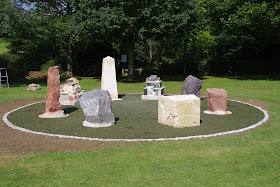 |
| Kate Hibbert, University of Bristol |
Postgraduate students at
the University of Bristol are heavily involved with outreach teaching
activities, visiting Bristol schools to talk about various topics in Earth
Sciences. Volunteers are co-ordinated by the STEM ambassador scheme. The aim of
the scheme is to get more young people involved with STEM subjects (Science,
Technology, Engineering and Maths) and it effectively acts as a matchmaker
between schools and willing expert volunteers. The network includes
professionals as well as university students. STEM ambassadors go in to schools
and might, for example, run a workshop, provide mentoring for a small group,
talk to an after school club or take part in a careers fair.
Bristol students have
been involved in several projects, including the Bristol Dinosaur Project.
Thousands of school children of all ages have had a visit from the Dinosaur
Project team, giving them the opportunity to learn about this dinosaur unique
to the Bristol region in an interactive workshop. The session also involves a
life-sized jigsaw of the Bristol dinosaur and handling real fossil specimens,
an activity that never fails to spark the imagination.
But it’s not just dinosaurs that can inspire children – workshops run by Bristol Earth Sciences PhD students have covered a wide range of topics, from the rock cycle to volcanoes to meteorites. A workshop might involve handling rock specimens, squashing plasticine to learn how a metamorphic rock is made, or using the classroom to reconstruct the scale of the solar system.
 |
| Primary school children getting some hands-on experience of life as a palaeontologist. Photo credit: Bristol Dinosaur Project |
But it’s not just dinosaurs that can inspire children – workshops run by Bristol Earth Sciences PhD students have covered a wide range of topics, from the rock cycle to volcanoes to meteorites. A workshop might involve handling rock specimens, squashing plasticine to learn how a metamorphic rock is made, or using the classroom to reconstruct the scale of the solar system.
The benefits of these
school visits are not limited to imparting knowledge
about the topic covered, but also come from allowing children to meet
‘real-life scientists’, helping to break down some of the stuffy scientific
stereotypes and encourage more people into science subjects and science
careers. The rewards for volunteers are great, not least giving confidence in
public speaking. If you can successfully hold the attention of a classroom of
10 year-olds, then giving a professional presentation seems significantly less
daunting!
Kate Hibbert
Links:
If you’re interested
in the STEM ambassador scheme or want to arrange for an ambassador to visit
your school: http://www.stemnet.org.uk/content/stem-ambassadors
A previous blog post about the Bristol
Dinosaur: http://avonrigsoutcrop.blogspot.co.uk/2012/02/bristol-dinosaur-project.html




















